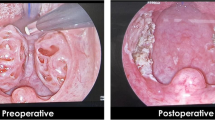Abstract
As the use of electrodissection in tonsillectomy increases, uncertainty remains concerning any association with postoperative haemorrhage. However, there is some evidence to suggest that the more diathermy is used the risk of postoperative haemorrhage increases. The technique of vessel dissection and diathermy tonsillectomy (VDDT) is described and the results of 335 consecutive cases are presented. The results are discussed in relation to bipolar diathermy tonsillectomy and microbipolar diathermy tonsillectomy and also the U.K. National Prospective Tonsillectomy Audit. It is concluded that VDDT has the advantages of cold dissection while reducing diathermy to a minimum.





Similar content being viewed by others
References
Weimart TA, Babyak JW, Richter HJ (1990) Electrodissection tonsillectomy. Arch Otolaryngol Head Neck Surg 116:186–188
Younis RT, Rande H, Lazar RH (2002) History and current practice of tonsillectomy. Laryngoscope 112:3–5
Murty GE, Watson MG (1990) Diathermy haemostasis at tonsillectomy: current practice—a survey of U.K. otolaryngologists. J Laryngol Otol 104:549–552
Pang YT, El-Hakim H, Rothera MP (1994) Bipolar diathermy tonsillectomy. Clin Otolaryngol 19:355–357
Andrea M (1993) Microsurgical bipolar cautery tonsillectomy. Laryngoscope 103:1117–1178
Saleh HA, Cain AJ, Mountain RE (1999) Bipolar scissor tonsillectomy. Clin Otolaryngol 24:9–12
Temple RH, Timms MS (2001) Paediatric coblation tonsillectomy. Int J Paediatr Otorhinolaryngol 61:195–198
Leinbach RF, Markwell SJ, Colliver JA, Lin SY (2003) Hot versus cold tonsillectomy: a systematic review of the literature. Otolaryngol Head Neck Surg 129:360–364
Van der Meulen J (2004) Tonsillectomy technique as a risk factor for postoperative haemorrhage. Lancet 364:697–702
Pang YT (1995) Paediatric tonsillectomy: bipolar electrodissection and dissection/snare compared. J Laryngol Otol 109:733–736
Pizzuto PM, Brodsky L, Duffy L, Gendler J, Nauenberg E (2000) A comparison of microbipolar cautery dissection to hot and cold knife cautery tonsillectomy. Int J Pediatr Otorhinolaryngol 52:239–246
Kujawski O, Dulguerov P, Gysin C, Lehmann W (1997) Microscopic tonsillectomy: a double-blind trial. Otolaryngol Head Neck Surg 117:641–647
Wei JL, Beatty CW, Gustaffson RO (2000) Evaluation of post tonsillectomy hemorrhage and risk factors. Otolaryngol Head Neck Surg 123:229–235
Pinder D, Hilton M (2004) Dissection versus diathermy for tonsillectomy. Cochrane Database Syst Rev 4:1–16
Berkowitz RG, Zalal GH (1990) Tonsillectomy in children under 3 years of age. Arch Otolaryngol Head Neck Surg 116:685–686
Acknowledgment
Mr N. Balaji, Monklands Hospital for reviewing this paper.
Author information
Authors and Affiliations
Corresponding author
Rights and permissions
About this article
Cite this article
Barr, G.D. How to reduce diathermy in tonsillectomy: description of technique and analysis of results. Eur Arch Otorhinolaryngol 264, 669–673 (2007). https://doi.org/10.1007/s00405-007-0245-9
Received:
Accepted:
Published:
Issue Date:
DOI: https://doi.org/10.1007/s00405-007-0245-9




